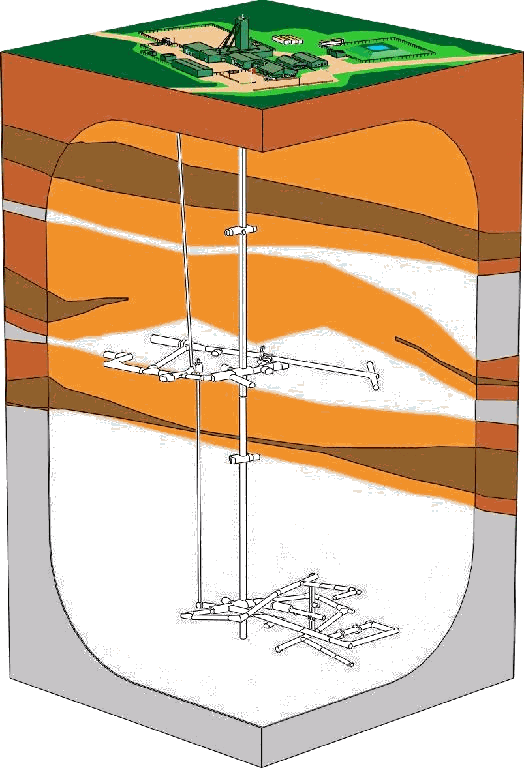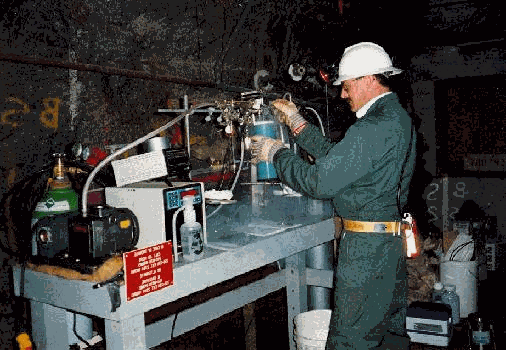The Underground Research Laboratory
|
||||||||||||
 The Underground Research Laboratory (URL) is located in southeastern Manitoba,
near the town of Lac du Bonnet, about 130 km from of Winnipeg by highway. On surface, the
URL, with its prominent 27-m-high headframe, appears to be a small mining operation
typical of those found across Canada. Despite the resemblance, the URL is very different
from a mine. It is a research centre constructed by Atomic Energy of Canada Limited (AECL)
to carry out large-scale testing, in situ engineering and
performance-assessment-related experiments on key aspects of geological disposal of
nuclear fuel waste from Canada’s CANDUÒ reactors. The Underground Research Laboratory (URL) is located in southeastern Manitoba,
near the town of Lac du Bonnet, about 130 km from of Winnipeg by highway. On surface, the
URL, with its prominent 27-m-high headframe, appears to be a small mining operation
typical of those found across Canada. Despite the resemblance, the URL is very different
from a mine. It is a research centre constructed by Atomic Energy of Canada Limited (AECL)
to carry out large-scale testing, in situ engineering and
performance-assessment-related experiments on key aspects of geological disposal of
nuclear fuel waste from Canada’s CANDUÒ reactors.Highly accommodating work space for up to 80 scientific, professional and technical personal is available. Offices, meeting rooms, laboratories, shops, data acquisition and global communication systems, storage facilities and security provide the infrastructure needed to support comprehensive R&D projects. In addition, the URL comprises a vertical access shaft to a depth of 443 m (by comparison the observation deck of the CN Tower is 346 m high) and major testing levels at depths of 240 m and 420 m -- each having several hundreds of metres of tunnels and test rooms. A bored ventilation raise connects the levels to surface. The URL is situated on the Lac du Bonnet granite batholith. The land, about 4 sq. km, is leased from the Province of Manitoba. The granite rock is representative of intrusive igneous (hard) rock found throughout the Canadian Shield and the Rocky Mountains. The close proximity to the Whiteshell Laboratories, a major R&D facility, and the presence of extensive rock outcrops on surface were factors in selecting the location of the site. Work started at the URL in 1980 with the drilling and instrumentation of more then 180 boreholes, some over 1000 m deep. These boreholes provided access to geological information concerning the rock mass and base groundwater conditions at the site. Undisturbed conditions were monitored for a considerable period before underground construction began in 1983. Changes to the rock mass conditions were then carefully measured during construction, which was completed in 1990. Excavations are situated below the water table and construction work was fully integrated with geotechnical activities. The URL is now in the operating phase. The specific areas of research, development, and demonstration include:
The operating phase is planned to continue until 2011. Nuclear Fuel Waste Management (NFWM) ProgramThe URL is a key component of the NFWM program, providing valuable experience in underground characterization and construction that could not have been obtained in any other way. Field data gathered at the URL have been applied to the preparation of several of the nine primary reference documents which support an Environmental Impact Statement (EIS). The EIS presents the concept for nuclear fuel waste disposal and was scrutinized by the Canadian Environmental Assessment Agency (CEAA) in public hearing across Canada. Geotechnologies Besides providing valuable input to the Concept Review, the URL has helped our understanding of the deep geological environment in a granite pluton (an area where there had been little previous information). The extreme variability in hydraulic characteristics of highly and moderately fractured zones have been extensively studied. Geophysics groups made use of standard and high-tech methods, such as ground penetrating radar, to develop a three-dimensional representation of the geology and structure (fracturing) of the rock mass. Data on chemical, isotropic and microbial compositions of the rocks, minerals and groundwater was used to calibrate and validate hydrogeologic models.
Hydrogeology and Hydrogeochemistry Site Characterization The geomechanical group has extensive experience in rock mechanics instrumentation and data acquisition related to measuring rock deformation and in situ stress. High rock stresses at relatively shallow depths were experienced at the URL and dealt with by applying sound geomechanical engineering principles. Excavation & Construction TechniquesDuring shaft sinking and subsequent level development, geotechnical activities were fully integrated with excavation and construction to provide up-to-date information concerning rock mass characteristics as headings advanced. The "observational method", a process commonly used in underground civil projects, was introduced to improve upon the design and construction process. This is an interative process that provides a continuous cycle of design, assessment and adjustment. Quality control procedures were prepared and a quality-based incentive system was implemented to ensure crews followed designs precisely. A full-face blasting method utilizing a burn-cut was developed for shaft sinking at the URL. Safety and productivity related issues associated with full-face shaft sinking were resolved and procedures developed.
Demonstration of Excavation Stability
Under High Demonstrations carried out during excavation of tunnels on the 240 level have shown it possible to excavate long blast rounds -- exceeding 2-times the tunnel diameter. Blast designs employed controlled drilling and blasting techniques that reduce the damage to the walls to the tunnel. Rounds up to 8.7m (28ft.) in length were advanced in a single blast. Centre for Geotechnical ExcellenceThe URL plays an important role as a "showcase" for R&D, as the facilities provide an opportunity for convincing visual and hands-on demonstrations of new developments in geotechnology. Leading edge R&D has attracted international attention and collaboration. The flags of France, Hungary, Japan, Sweden, the UK, and the USA are displayed at the entrance to the site, attesting to international cooperation on experimental work. Knowledge gleaned from the URL can be applied to tunnelling and underground civil projects. The URL is available to organizations wishing to carry out R&D needed to enhance operations or demonstrate capabilities. |
||||||||||||
|


